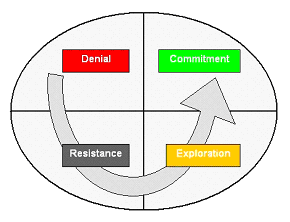Creating an article on managing change in today's business environment requires caution, as change comes in so many guises. However, I find the ideas provided here are sound guidelines for most situations I have encountered. I hope there is value to you in my sharing them with you.
 I find management and business models about technological advances, global influences and virtual offices are freely available. However, these can be too theoretical to absorb and really use in a situational context. And I have a strong preference for plain speak related to real workplaces!
I find management and business models about technological advances, global influences and virtual offices are freely available. However, these can be too theoretical to absorb and really use in a situational context. And I have a strong preference for plain speak related to real workplaces!
So, let's focus on what factors differentiate a successful manager of change - or makes one a driver of positive and intentional change. What combination of factors will impact on your people, retain and stretch the brilliant, and still not scare off those who want a "steady, normal" job...?
Considering the scholarly dissertations available, it seems simplistic to say that to manage change one merely needs to understand a few points. However, as a manager of over 25 years standing in many environments, I've discovered that in most situations I absolutely must focus upon three factors. These are:
Personality and individual differences
Start with the individual, preferably you. Do you know what thinking style, paradigms and patterns of management you have? Does this understanding factor into your day-to-day management style? What about other managers, team leaders, staff in each division, even your contractors... everyone plays their part in whether change happens smoothly - or not!
Many people reading this will have had a psychometric assessment done at some point in time. How many of you can recall, let alone effectively use, these results in a situation of change? (Hmmm... I can hear you say ... I was an EFJ3... or something like that...)
How about digging out those reports? Get some fresh guidance on how to use them and be able to anticipate staff behaviour during times of change? Different people have different levels of reluctance, enthusiasm, or may need to know details and timelines. Some really do need to know the "big picture" before they can work with the details - for others this is mere padding, and they want to work with smaller chunks of information.
Knowledge about people can provide a very direct and effective key to making them feel confident to proceed. Failing to understand these needs can cause your team to withdraw, start making faulty decisions, and become concerned. However, as this is subtle, they may be unable to express clearly just what is wrong. This can lead to emotive decision-making and unnecessary levels of angst. There are opportunities to avoid this with a sound understanding of and respect for diversity - particularly intrinsic diversity such as personality.
The change cycle
We can look to some simple but sound theory underpinning change. Many experts have written on this subject, most with very sound, but differing "rules" for getting it "right". Frankly, each change is different, driven perhaps internally or externally, intentionally or foisted upon one. Therefore the more adaptive the leader, the more insightful and willing they are to explore options, the better most change projects will proceed.
A four-phase model of denial, resistance, exploration and commitment is a simple but seemingly effective indicator of reactions to change by individuals or groups.

Source: Jaffe & Scott
Think hard about how each person, if they were standing on each part of the curve, would be interpreting the behaviours of those who are standing on a different part of that continuum. Think about yourself, regarding a change you have experienced. Do you recognise the curve in your processing of events? How did you feel about others who may have had polarised views to your own. What would a group in the denial "camp" be actually saying (or internally saying to themselves) about those over there in the commitment - who are busily trying to implement the initiative? Hmmm... perhaps: "crawlers, dreamers, crazy..." What about those in denial, would the other three groups be saying "get real, accept the facts, get your heads out of the sand..." It is not hard to see how conflict can arise. Nor is it hard to see the need to control this process.
Richard Beckhard and David Gleicher developed a "formula for change" (Gleicher's Formula). This seems to describe quite accurately in my opinion what the leader may have to analyse, communicate and focus on, when driving change initiatives. The formula states the combination of organisational dissatisfaction, vision for the future and the possibility of immediate, tactical action (first, concrete steps) must be stronger than any resistance before meaningful change could happen (D x V x F > R).
Beckhard & Gleicher state these three items are a must for successful change. If the group's understanding of DVF are clearer and stronger than resistance, then change is possible. Naturally, the understanding of DVF is often achieved by good communication and insightful management.
The question is, how do we ensure people interpret unplanned change in a way that leads them towards dissatisfaction with the status quo? How do we instill vision and take those steps towards the future? The answer is often good planning, preferably with a series of SMART (Specific, Measurable, Achieveable, Realistic and Time Framed) goals. We must engage with this ourselves however and accept that it is up to the leader to take those first, concrete steps.
Communication project
Like food (and quoting a Hobbit from J.R.R. Tolkien) communication should be supplied in terms of "lots and often". There must also be variety. No one method is appropriate, effective, nor reliable.
Managers need look no further for conceptual guidance than to their OH&S Committee's responsibilities for communication methodology. Regular meetings, seeking opinions and ideas, written and verbal information flow - scheduled and ad-hoc, visual stimulus and creating culture building symbols. Firstly however, a manager needs the desire to reach out to the least communicative employees via creative and proactive efforts.
This all sounds like hard work doesn't it? However, with staff replacement costing up to three times an employee's annual wage, it is hard work that will effect a saving in the long term for the bottom line.
An example of what not to do...
I observed one company many years ago get this seriously wrong. With about 80 sites, they needed to downsize substantially, along with reinventing themselves as a tightly formed, commercially competitive business. They targeted emerging with 20 outlets nationally. In their Management and staff they had some brilliant talent, along with others that had been awaiting redundancy for many years. So in some ways it was not a terribly hard project to change manage, as the "grief" factor was not overwhelming and redeployment options were sound.
It was an employees market at that time, and let's look at what the Board of Management did wrong. They put out a couple of memos, promising swift and clear communication. Then just at a crucial point where there was lack of understanding about new opportunities, in mid-December, they went on Christmas vacation. Oh, so clever! No more communication to staff feeling insecure until mid February. You can imagine how many people had applied for other jobs in that eight-week period "just in case". You will also no doubt realise how many of those "brilliant" staff received job offers. Right again! Who was left to start up the new commercial structure... the people who preferred early retirement. Not a recipe for success!
The message that was sent quite unintentionally by the Board was this: "We are exhausted, stressed. We don't care about your futures. We are confused and need a break. You will hang around anyway - we are so much more important than you are that we can afford to be blasé ..." Naturally, this was not the case, but it resulted in a less than easy change project for those that remained, and the new company - well, I haven't seen their logo for years...
Finally, change management solutions
Get out that project management model and dust off the spreadsheets - plan out a sound communication pattern and engage multiple staff in the implementation. Consider revisiting personality information and/or run a team building-session that includes assessment and discussion. Make appropriate use of this data for task allocation and support actions. Think hard about how to NOT lose people, physically or motivationally. Map out long-term, mid-term and short-term goals and reward yourselves for achievement. This may not be a full solution, but it will convince your team you believe they matter, and that you are a proactive leader.
References:
Beckhard, R Organisation Development: Strategies and Models, 1969.
Jaffe, D.T & Scott, C.D, Mastering the Change Curve, 2nd Ed. 2003.
Tolkien, J.R.R. The Hobbit, 1937.